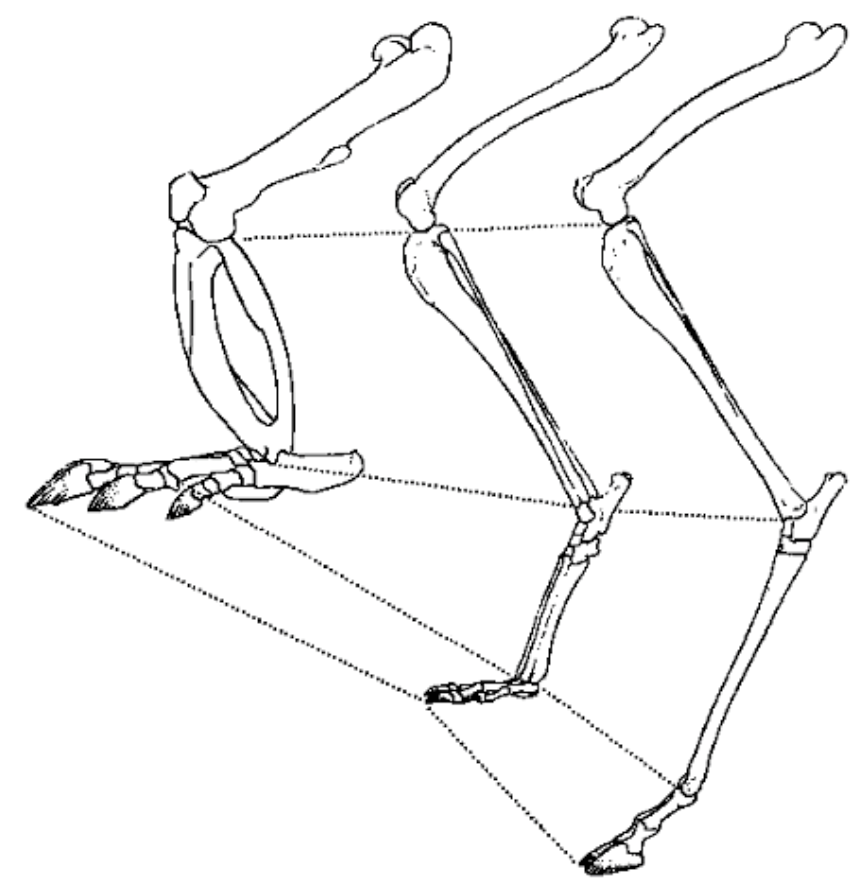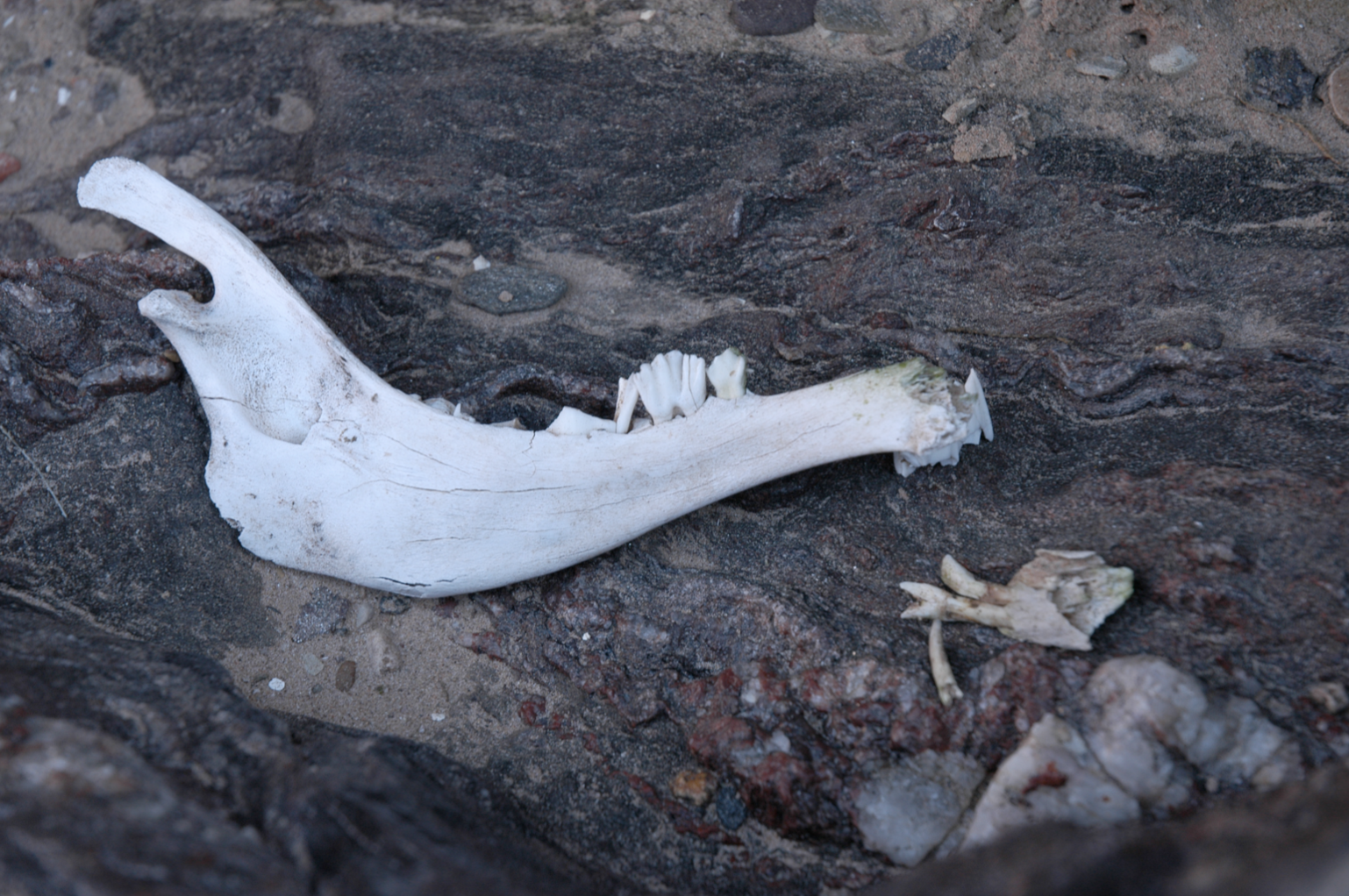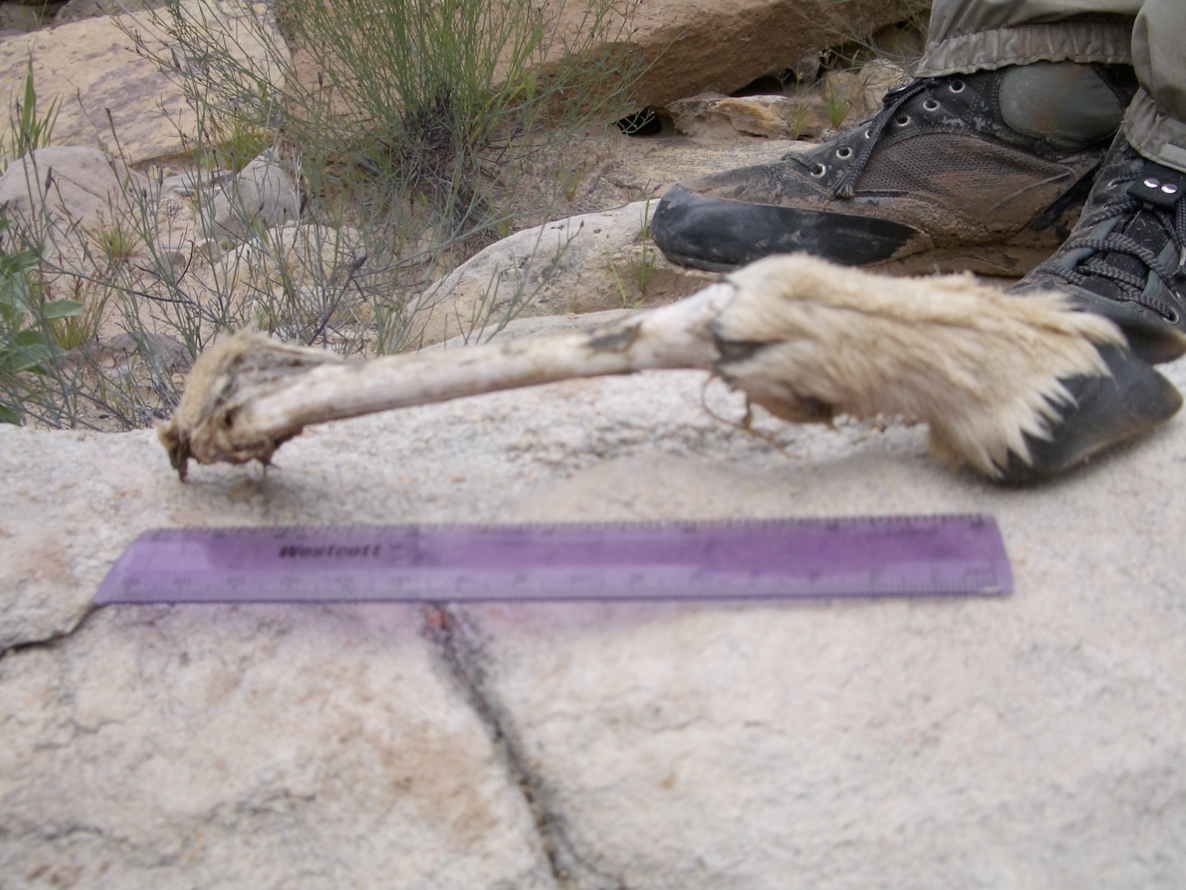INTRODUCTION
Bighorn sheep (Ovis canadensis) are some of the most charismatic and recognizable fauna of the Grand Canyon. We saw them high on the cliffs of the canyon walls on three occasions (Fig. 1), and found evidence of them at many other sites. Evidence we found included tracks, scat, bones, and other remains.

Figure 1. A female bighorn sheep, likely pregnant, spotted in the Tapeats sandstone of the Colorado River corridor through the Grand Canyon (Photo: Jessica Dettman).
Bighorn tracks look similar to deer tracks, but are 3 to 3 _ inches long (the hind feet are slightly longer than the front feet), and are less pointed, less heart-shaped, and less curved around the edges than a deer’s (Fig. 2).
Bighorn are in order Artiodactyla (even-toed ungulates), and their two-hoofed, even tracks show this accordingly. Having two hooves provides an advantage in clinging to steep cliff terrain, which is a necessary adaptation for bighorn’s cliff dwelling lifestyle. A bighorn’s stride can range from less than two feet to near 30 feet, so distance between tracks can give you an idea of how fast the animal was moving. Bighorn scat is also similar to deer scat, but it tends to have a point on one end of the pellet (as opposed to being uniformly round), which gives it a bell-shape (Fig.3).

Figure 2. A bighorn track (Source: http://homestudy.ihea.com/wildlifeid/032bighornsheep.htm).

Figure 3. Bighorn scat found at Elves’ Chasm (Photo: Jessica Dettman).
DESCRIPTION OF BONE REMAINS
The most interesting evidence of bighorn sheep that we found in the canyon were multiple bone remains of juvenile bighorn in many of our campsites and research areas. We found a small rear lower leg bone with no hoof and little fur remaining at river mile 99. Like many ungulates, bighorn have fused lower leg bones. Specifically, they have fused metacarpals and metatarsals to provide strong support for their unguligrade posture (Fig.4). This fusion also makes their extremities lighter, therefore making them faster and more agile.

Figure 4. Bighorn sheeps’ unguligrade posture is shown on the far right. The central diagram shows digitigrade posture, typical of a bobcat or coyote. The leftmost diagram shows plantigrade posture, typical of humans or bears. (Source: http://www.shsu.edu/~bio_mlt/ungulate.html).
We also found a small lower jaw bone at Bass Camp (approximately river mile 108) on our second night (Fig. 5). It was identified as being from a juvenile bighorn because of its size and the hypsodont molariform teeth with a selenodont cusp pattern. In other words, the teeth were typical of a Bovid (bighorns are in the family Bovidae) and the teeth were very sharp, indicating little use.
At river mile 120 we found a small front leg bone that still had the hoof and some fur attached (Fig. 6). Bighorn hooves are easily identifiable as described above, and they also are interesting because they are harder along the outside edges and spongier in the middle when compared to deer hooves. Again, this feature helps them maintain balance on steep cliffs.
At river mile 120, in another location, we also found an almost intact juvenile bighorn skull. This skull and the leg bone mentioned above may have belonged to the same bighorn individual. We identified the skull as being from a bighorn because it had orbitals that were extruding from and set far back on the skull. This skull shape is characteristic of family Bovidae. The skull was considered to be from a juvenile because it had small, sharp teeth and tiny budding horns. At river mile 123 we found one rib and two vertebrae, which we also decided, were from a bighorn based on their size and shape. Many ungulates have strong vertebrae to support the nuchal ligament that holds up their heavy heads, and the thickness of the vertebrae we found suggested that they were from an ungulate.

Figure 5. This lower jaw bone was found at Bass Camp, and represents the remains of a young bighorn sheep (Photo: Rene Henery).
CAUSES OF MORTALITY
Based on the number of separate remains we found, it appears that death of juvenile bighorn sheep is frequent in the Grand Canyon. Young bighorns can walk and climb almost as well as their mom within a day of being born, but usually remain hidden for the first week of their lives (Whitaker 1998). After this time, they start following their mom around wherever she goes and quickly become adept climbers. The possible causes of death for these young bighorn include falling, predation, and disease.
Although the cliff habitat of bighorns is useful for avoiding predation and minimizing competition with other herbivores, falling from these cliffs can easily lead to death. Bighorn sheep are skillful climbers and have good traction, but accidents do happen. Young bighorn are presumably more at risk for dying from a fall because they have less experience traversing the cliffs. The jaw found at Bass Camp contained shattered molars. Teeth are made of very hard bone, and are therefore difficult to break. Broken teeth are not likely to be caused by predation or disease, and so we assumed that this young bighorn had died from a fall. Falling from cliff edges is a realistic concern for young bighorn sheep.

Figure 6. This foreleg bone was found at river mile 120, and belonged to a young bighorn sheep (Photo: Jessica Dettman).
Predation is another possible cause of death for bighorn sheep, and young bighorns are more vulnerable. In bighorns’ rocky cliff habitat, most predators cannot reach them. However, mountain lions (Puma concolor) are capable of navigating cliff habitat (Whitaker 1998), and therefore represent a threat. The fact that all of the bone remains we found were only parts of skeletons suggests that pieces of the dead individuals were distributed by a predator and/or scavengers. Mountain lions are rare in the Grand Canyon (Dettman 2005), but it still remains possible that one or more of the remains we found were the result of mountain lion predation.
Disease is the final possibility for bighorn sheep mortality. Our river guides had heard recent accounts of sickness in young bighorn sheep (Billie Prosser, pers. comm.), which suggests that some of the remains we found could have been from diseased individuals. It is presumed that bighorn populations have increased since the installation of Glen Canyon Dam (Dettman 2005) and the removal of feral burros from the Grand Canyon. Higher population sizes may permit easier and more frequent transmission of disease, which could explain recent disease trends.
Overall, the numerous remains of bighorn sheep we found indicate that juvenile bighorns have a considerable mortality rate. The source of this mortality is attributable to falling, predation, disease, or some combination of these three. Although bighorns’ cliff dwelling lifestyle has its advantages, some causes of mortality cannot be avoided.
REFERENCES
Dettman, J.A. 2005. “Glen Canyon Dam: A mixed blessing for mammals, reptiles, and amphibians?” In. J. Mount, P. Moyle and C. Hammersmark (eds.). Ecogeomorphology of the Grand Canyon and its Tributary Streams. Davis, CA. http://watershed.ucdavis.edu/grand_canyon/history.html.
Whitaker, Jr., J. O. 1998. National Audobon Society Field Guide to North American Mammals. Alfred A. Knopf, New York.
